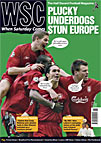 Dave Jennings went to Bradford’s last match of the season in 1985 and lived to tell the tale, but 56 of his fellow supporters died in the fire that engulfed Valley Parade
Dave Jennings went to Bradford’s last match of the season in 1985 and lived to tell the tale, but 56 of his fellow supporters died in the fire that engulfed Valley Parade
On the morning of May 11, 1985, it felt great to be a Bradford City supporter. The club had been rattling around in the bottom two divisions of the Football League for 58 years, but at last City were moving on up. The Third Division championship was already ours, so the final game of the campaign was meaningless in competitive terms. But 11,076 turned out anyway for the home match against Lincoln. We Bradford fans wanted to celebrate and watch captain Peter Jackson collect the Division Three trophy.
I had a good view of the presentation, despite the thick wire fence in front of the terrace at the Bradford end of the ground. An hour or so later, I was one of many frightened people scrambling over the same fence to reach the safety of the pitch, as the stand to our left turned into a huge rectangle of flame.
With around five minutes of the first half remaining, a small fire broke out near the back of Block G of Valley Parade’s main stand, probably started by a dropped cigarette end or a match. Police and stewards moved people away from the fire. The game was stopped and the players went off, but even at that stage it appeared that the fire could probably be contained and extinguished without major damage being done. Then the fire ignited piles of rubbish hidden under the stand and finally a gust of wind spread the blaze upwards to the stand’s roof, which burned with horrifying ease and speed. Within four minutes, the whole of the roof and the old wooden stand beneath were ablaze. A television crew there to record a football match found themselves providing live coverage of a catastrophe, commentating as people staggered out of the stand with their clothes on fire.
I emerged from the chaos with nothing worse than a scratched leg from the perimeter fence. On the way out of the ground, I listened to a local station on my pocket radio. First reports assured listeners that there didn’t appear to have been any fatalities. But over the hours that followed, as members of the emergency services worked through the night to search the burned-out stand, the horrible truth slowly became clear. The unluckiest people in Valley Parade that day were those who had attempted to escape the blaze via the rear gates, only to find them locked.
The final death toll was 56, with many more injured. Bradford Royal Infirmary treated 190 people in three hours that night and a team of 13 surgeons specialising in burns was hastily brought together from the staffs of hospitals in the region. Fifty-seven patients were operated on over the next three days.
An official inquiry was rapidly convened, with High Court judge Sir Oliver Popplewell in charge of the hearings. The inquiry’s conclusions led to the drafting and passing of the Fire Safety and Safety of Places of Sport Act 1987, which required any sports stand with a capacity of 500 or more to have its fire safety certified by local authority officials. Safety standards at British football grounds improved a little – though nowhere near enough, as events at Hillsborough in 1989 would soon demonstrate all too clearly.
The horrific TV pictures helped to inspire an impressive public response. More than £3 million was raised for a Bradford Disaster Appeal Fund and by November 1985 most of the money had been distributed to surviving victims of the fire.
Bradford City went into exile for a season and a half, playing at Leeds and Huddersfield before finding a longer-term temporary home at Odsal Stadium, the Bradford rugby league venue. Calling Elland Road or Leeds Road “home” would have been anathema to City fans in other circumstances, but we’d had a cruel reminder that football really is only a game.
Valley Parade reopened in December 1986 and the site of the disaster is now the location for the imposing Sunwin Stand. Outside the stand is a poignant sculpture of leaping footballers and a mourning woman, created in response to the disaster. A memorial nearby lists the names of those who went to see that end-of-season game against Lincoln and never returned. And whenever the debate about the safety of standing at football is reopened, I remember the day that choosing the terraces possibly saved my life.
From WSC 220 June 2005. What was happening this month